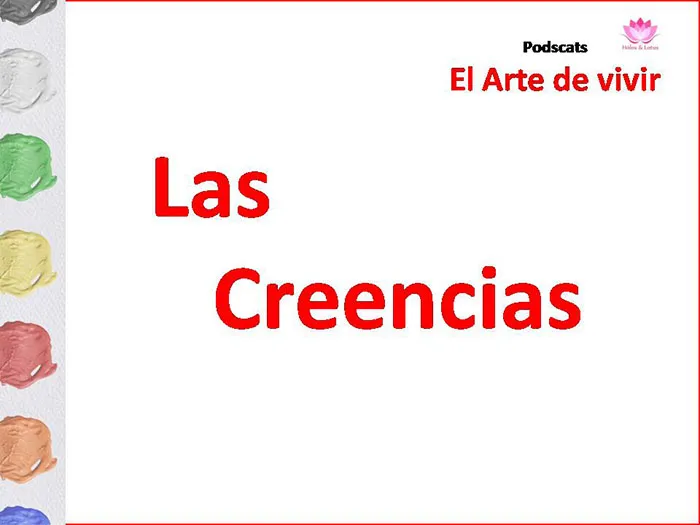
En la noche de ayer 13 de enero dimos inicio a nuestro primer Podscast de “El Arte de Vivir”, acompañadas por un grupo de amigos: @zonadigital21, @mafalda2018, @fragozar01, @irvinc @Aurodivys, @jomarby, @rosahidalgo, @edwing357, @charsdisegn, @lisfabian, @Beast855, @@@aguamiel, @Ayleenr @JoilenGallardo19, cuyas participaciones llenaron el espacio de una energía tan positiva que @miriannalis y yo, al comentar la actividad realizada, emocionadas y satisfechas no dudamos en catalogarla como exitosa. Gracias a todos los presentes y desde ya invitados para el próximo encuentro.
¿De qué hablamos?
“Las Creencias” fue el tema escogido para iniciarnos, un tema que indudablemente es fundamental, para desarrollar El Arte de Vivir porque desde las creencias interpretamos el mundo, ellas hablan de quiénes y cómo somos, de nuestra manera de comprender e interpretar la realidad, cómo actuamos y también qué esperamos de la vida.
Para entrar en calor con el tema presentamos una frase e invitamos a los participantes a interpretarla
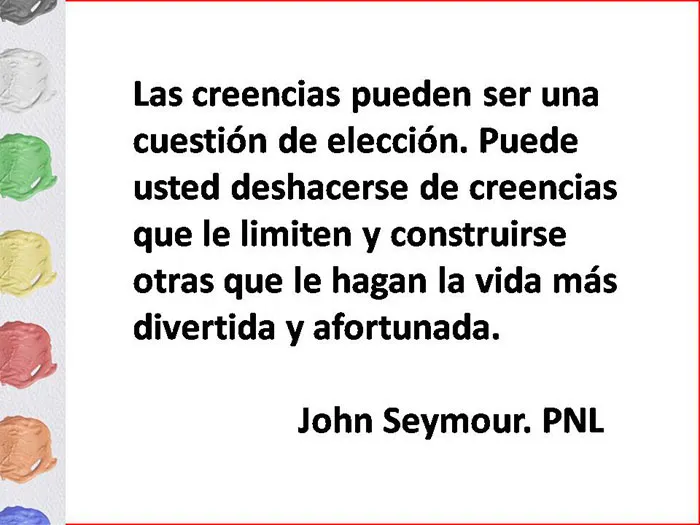
Algunos comentarios fueron:
Hay muchas creencias sociales que nos limitan. Por ejemplo, cuando tenía 22 años tuve la oportunidad de venir a trabajar en Caracas. Yo era un muchacho de pueblo y muchos de mis amigos y familiares me insistían que no viniera a la capital. Algunos me decían que era muy peligroso, otros como mi madre me decía que lo que iba a ganar lo gastaría en alquiler y otras cosas que ya las tenía. Lo cierto es que ya había tenido una experiencia muy parecida a esa, dos años antes y por esas creencias decidí no aventurarme, así que decidí no hacerles caso y me mudé. Creo que el haber desistido de esas creencias me dio muchas excelentes experiencias. @charsdesign
Así mismo es amigo mío, solo tú mismo conoces tus límites, así que ya cada uno logra lo que puede @zonadigital21
La sociedad con los paradigmas nos limitan pero hay que arriesgarse, hay que tomar decisiones buenas o malas. Y confiar en nuestras intuiciones y creencias. @Mafalda2018
Las creencias su nombre lo dice creer, es decir no está seguro es algo incierto, creer no es lo mismo a estar seguros y la única manera de estar seguro de algo es hacerlo por uno mismo. @Beast855.
De estos comentarios podemos extraer que nuestras creencias se forman, mayoritariamente, en la familia y el entorno, que solo uno puede conoce sus límites, que hay que tomar decisiones y que la creencias son inciertas.
Efectivamente las creencias tienen sus orígenes en la familia, la escuela, por alguien que consideramos una autoridad, las costumbres y por la propia experiencia. Ellas van creando un marco de conceptualizaciones que conforman ese espacio mental donde cada uno se mueve, sin embargo, más allá de tu mapa se abre un mundo por conocer y que a través de una frase muy significativa la PNL nos los define: “El mapa no es el territorio” significando con ello que nuestro mapa puede ser expandido, podemos abrirnos a otras realidades, a otras verdades, a otras creencias.
Con estos planteamientos abrimos la puerta de las creencias limitantes y creencias potenciadoras. Las creencias limitantes cuyas características y efectos las podemos resumir de la siguiente manera
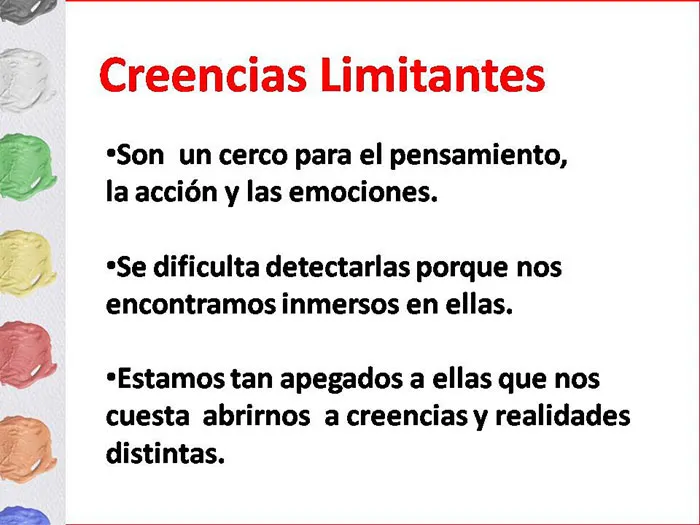
En el chat surgieron unos comentarios de los participantes que ilustran muy bien esta idea y que hoy releyéndolos, me causaron una gracia increíble. En un ejemplo que di sobre las creencias afirmaba que el sol era blanco y no amarillo como lo hemos descrito y pintados desde siempre. Aquí los comentarios:
Participante 1: —¿Qué el sol es blanco? Me entero, más tarde busco esa información.
Participante 2: Yo le digo eso a mi mamá y enseguida dice que soy daltónico.
Participante 3: O te pregunta: ¿Qué andas fumando que lo estas mirando blanco?
Lo primero que surge ante una idea que rompe con lo que nosotros creemos, es la incredulidad, posteriormente buscamos validarla hasta que finalmente la aceptamos y decidimos si la incorporamos a nuestro mapa. Estos son pasos para la transformación de nuestras creencias y que más adelante detallamos.
Pasamos a las creencias potenciadoras y @miriannalis nos presentó cuatro puntos que nos enfocan en los beneficios que aportan las creencias potenciadoras:
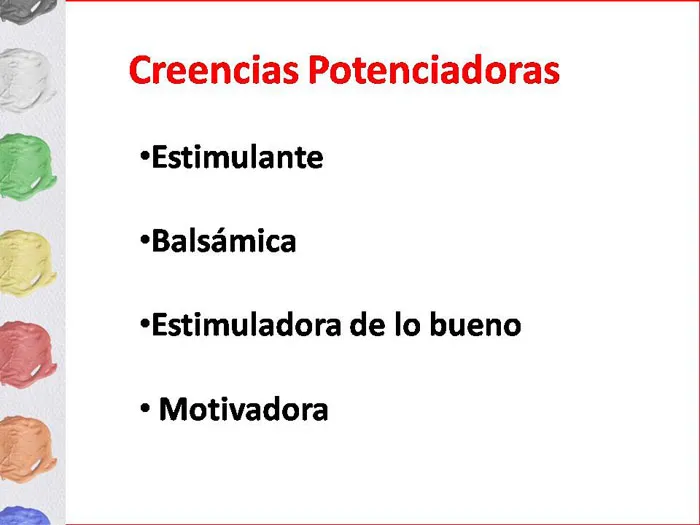
Los participantes muy amablemente fueron aportando ejemplos de creencias que nos impulsan y nos permiten entrar en sincronía con lo que pensamos, decimos, hacemos y sentimos. He aquí algunas de las que afloraron:
• La vida hay que llevarla con calma
• Realizo con pasión lo que me gusta
• Consigo herramientas para solucionar todo en la vida
• El Universo me acompaña en cada paso que doy.
Ya para cerrar el tema trabajamos tres técnicas para transformar una creencia limitante en una creencia potenciadora, partiendo del hecho que ya la hemos reconocido la creencia limitante y deseamos poner nuestra intención en ese proceso de transformación.

1.- Desmontar Esta primera técnica nos las presenta uno de los grandes maestros de la PNL, Anthony Robbins, llamada la técnica de la mesa que consiste en comparar la creencia limitadora con una mesa: la mesa es la creencia y las patas son lo que fundamenta la creencia. La idea general es ir aflojando las patas hasta desmontar la mesa, es decir la creencia. Trabajamos la idea con la siguiente creencia: A mí el dinero no me llega fácil. Comenzamos el trabajo preguntándonos:
¿En qué te basas, en qué te apoyas para afirmar esa idea?
¿Cuáles son las patas que sostienen tu percepción?: La familia ¿Cómo ha sido la relación de tu familia con el dinero, que escuchaste siempre del dinero?; Tu entorno: ¿Qué dicen las personas que te rodean sobre el dinero?; tu experiencia: Siempre ha sido a si o has tenido momentos en que el dinero llega a ti con facilidad?*
¿Puedes aprender a relacionarte de otra forma con el dinero?
La idea es que comiences a desmontar la creencia, que dudes de su solidez, que te plantees que no, necesariamente, siempre es así, que hay experiencias contrarias que dicen otra cosa.
2.- Afirmar: Una segunda técnica es trabajar conscientemente en la transformación de esa creencia, volverla otra, distinta, no se trata de cambiar sino de transformar y que esta nueva creencia se consolide en tu mente, palabra, acción. Veamos:
Construye una frase que describa la nueva creencia que quieres incorporar a tu vida y repítetela tantas veces como puedas durante el día. Ahora, la repetición no es como lorito, es que te detengas, pienses, sientas y pronuncies. Ejemplo de algunas frases:
- Soy abundante y prospera el dinero fluye en mi vida
- El dinero llega a mí con abundancia y facilidad.
- Tengo el trabajo que quiero y disfruto
- La vida está llena de posibilidades y yo las puedo ver.
3.- Enfocar: Si eres de los que creen en la frase: Ver para creer, y si no también, entonces enfoca tú atención en aquello que confirme tu nueva creencia. Por ejemplo:
- Ve programas referidos al tema.
- Visita páginas de internet sobre el tema
- Comparte en grupos de redes cuya temática vaya acorde con tu creencia.
- Ve, mira, observa a personas que en su accionar son practicantes de la creencia.
Con estas ideas fuimos cerrando el tema, hubo reparto de torta de chocolate, una música cargada de mensajes y mucho compartir de ideas. Un momento nutritivo y bello pintando la vida con lo que nos gusta.
Nuevamente, a cada uno: ¡Gracias por ser y estar!

In English
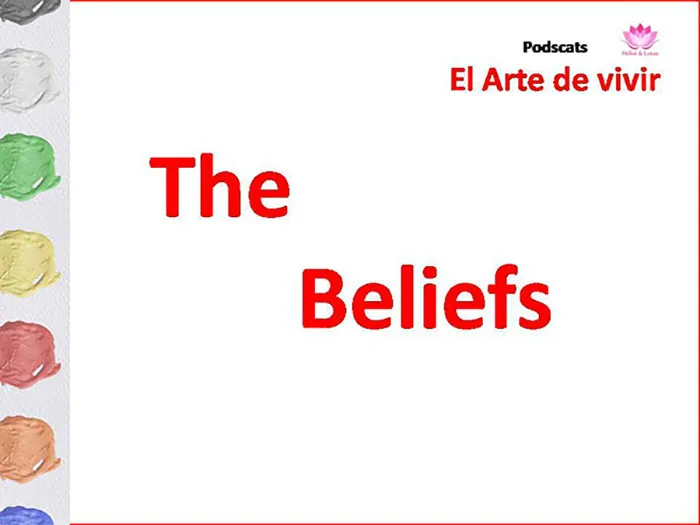
Last night January 13th we kicked off our first Podcast of "El Arte de Vivir", accompanied by a group of friends: @zonadigital21, @mafalda2018, @fragozar01, @irvinc @Aurodivys, @jomarby, @rosahidalgo, @edwing357, @charsdisegn, @lisfabian, @Beast855, @@@aguamiel, @Ayleenr @JoilenGallardo19, whose participation filled the space with such a positive energy that @miriannalis and I, when commenting on the activity carried out, excited and satisfied, did not hesitate to classify it as a success. Thanks to all those present and we are already invited for the next meeting.
What did we talk about?
"Beliefs" was the topic chosen to initiate us, a topic that is undoubtedly fundamental to develop The Art of Living because from the beliefs we interpret the world, they speak of who and how we are, of our way of understanding and interpreting reality, how we act and also what we expect from life.
To warm up with the topic we presented a phrase and invited the participants to interpret it.

Some comments were:
There are many social beliefs that limit us. For example, when I was 22 years old I had the opportunity to come to work in Caracas. I was a small town boy and many of my friends and family insisted that I not come to the capital. Some told me that it was too dangerous, others, like my mother, told me that what I was going to earn I would spend on rent and other things that I already had. The truth is that I had already had an experience very similar to that, two years before and because of those beliefs I decided not to venture, so I decided not to pay attention to them and I moved. I think that having given up those beliefs gave me many excellent experiences. @charsdesign
That's the way it is my friend, only you know your limits, so everyone achieves what they can. @zonadigital21
Society with paradigms limit us but we have to take risks, we have to make good or bad decisions. And trust our intuitions and beliefs. @Mafalda2018
Beliefs its name says so believe, ie not sure is uncertain, believing is not the same as being sure and the only way to be sure of something is to do it for yourself. @Beast855
From these comments we can extract that our beliefs are formed, mainly, in the family and the environment, that only one can know its limits, that it is necessary to make decisions and that the beliefs are uncertain.
Indeed, beliefs have their origins in the family, the school, by someone we consider an authority, customs and by our own experience. They create a framework of conceptualizations that make up the mental space where each one moves, however, beyond your map opens a world to know and through a very significant phrase NLP defines it: "The map is not the territory" meaning that our map can be expanded, we can open ourselves to other realities, to other truths, to other beliefs.
With these approaches we open the door to limiting beliefs and empowering beliefs. The limiting beliefs whose characteristics and effects we can summarize in the following way.
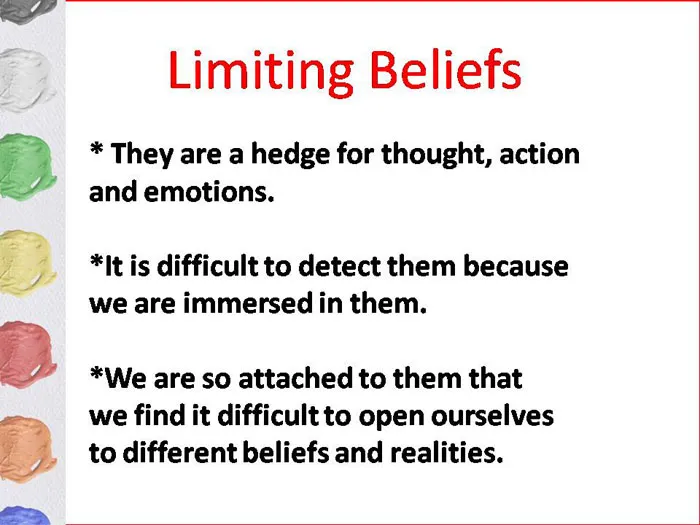
In the chat some comments of the participants came up that illustrate very well this idea and that today re-reading them, they caused me an incredible grace. In an example I gave about beliefs, I affirmed that the sun was white and not yellow as we have always described and painted it. Here are the comments:
Participant 1: -What the sun is white? I find out, later I look for that information.
Participant 2: I tell my mom that and she immediately says that I am color blind.
Participant 3: Or she asks you: What are you smoking that you are looking at it white?
The first thing that arises when faced with an idea that breaks with what we believe is disbelief, then we try to validate it until we finally accept it and decide whether to incorporate it into our map. These are steps for the transformation of our beliefs, which we will detail later on.
We moved on to empowering beliefs and @miriannalis presented four points that focus us on the benefits of empowering beliefs:
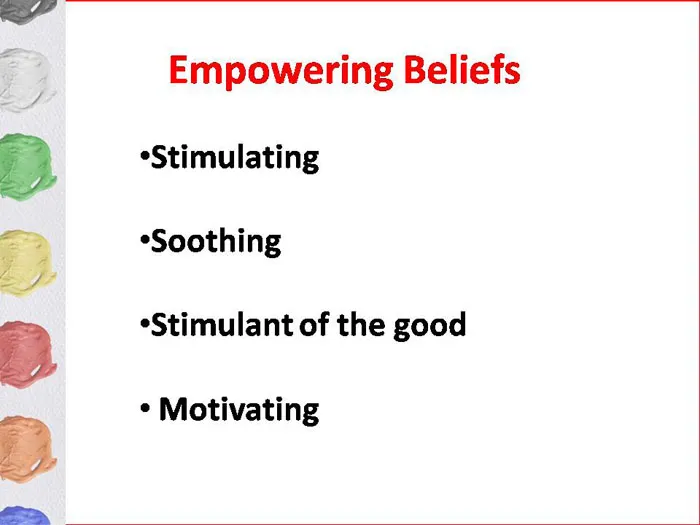
Participants very kindly provided examples of beliefs that drive us and allow us to get in sync with what we think, say, do and feel. Here are some of the ones that surfaced:
- Life has to be lived calmly
- I do with passion what I like
- I get tools to solve everything in life
- The Universe accompanies me in every step I take.
To close the theme we worked on three techniques to transform a limiting belief into an empowering belief, starting from the fact that we have already recognized the limiting belief and we want to put our intention in this process of transformation.
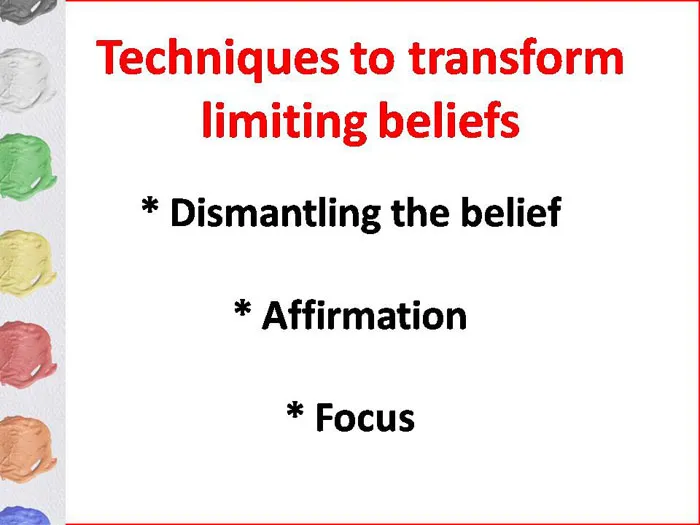
1.-Disassemble This first technique is presented to us by one of the great masters of NLP, Anthony Robbins, called the technique of the table, which consists of comparing the limiting belief with a table: the table is the belief and the legs are what supports the belief. The general idea is to loosen the legs until the table, i.e. the belief, is dismantled. We work the idea with the following belief: Money does not come easy to me. We begin the work by asking ourselves:
On what do you base, on what do you support yourself to affirm this idea?
What are the legs that support your perception: Your family: How has your family's relationship with money been, what have you always heard about money; Your environment: What do the people around you say about money; Your experience: Has it always been the same or have you had moments when money comes to you easily?
Can you learn to relate differently to money?
The idea is that you begin to dismantle the belief, that you doubt its solidity, that you consider that it is not necessarily always so, that there are contrary experiences that say otherwise.
2.-Affirm A second technique is to consciously work on the transformation of that belief, to turn it into another, different, it is not about changing but transforming and that this new belief consolidates in your mind, word, action. Let's see:
Construct a phrase that describes the new belief you want to incorporate into your life and repeat it to yourself as many times as you can during the day. Now, repetition is not parroting, it is you stopping, thinking, feeling and uttering. Example of some phrases:
- I am abundant and prosperous money flows into my life.
- Money comes to me with abundance and ease.
- I have the job I want and enjoy
- Life is full of possibilities and I can see them.
3.- Focus: If you are one of those who believe in the phrase: Seeing is believing, and if not also, then focus your attention on that which confirms your new belief. For example:
- Watch programs related to the topic.
- Visit websites on the subject.
- Share in networking groups whose subject matter is in line with your belief.
- See, watch, observe people who in their actions are practitioners of the belief.
With these ideas we were closing the theme, there was a chocolate cake distribution, a music full of messages and a lot of sharing of ideas. A nourishing and beautiful moment painting life with what we like.
Once again, to each one of you: Thank you for being and being there!

Translated with www.DeepL.com/Translator (free version)
Fuente de imágenes: Archivo Personal



MIS REDES SOCIALES




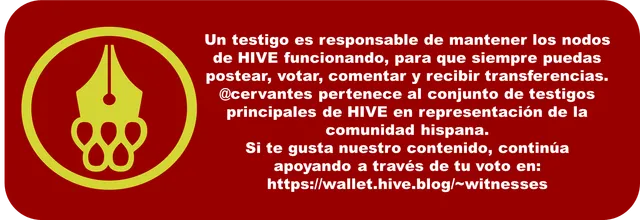
Te invito a apoyar este proyecto como witnes y a formar parte de esta gran comunidad uniéndote a su Discord en el siguiente enlace:
Discord de la comunidad Cervantes




